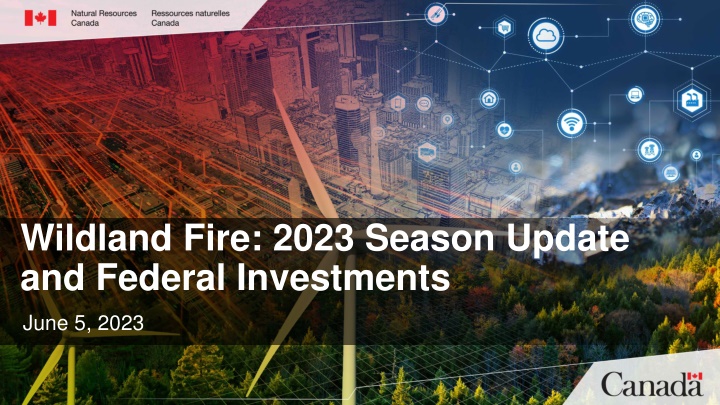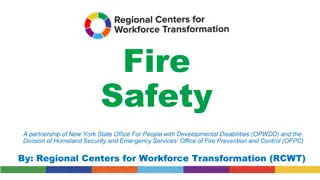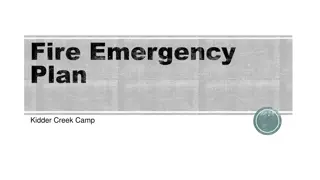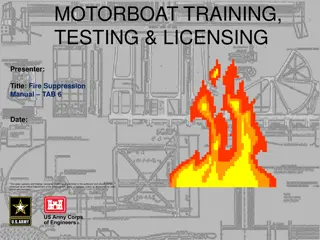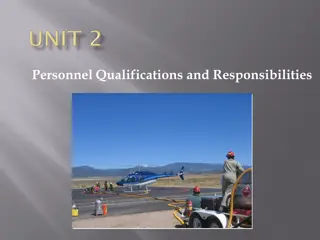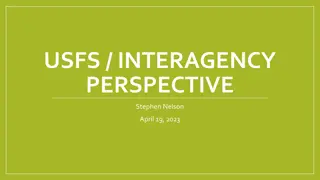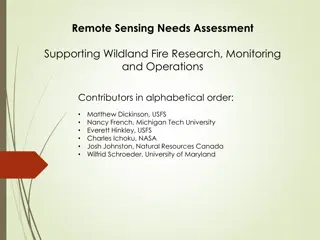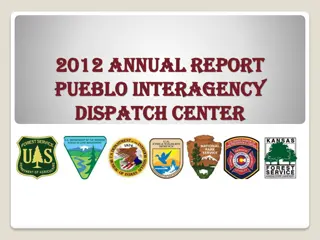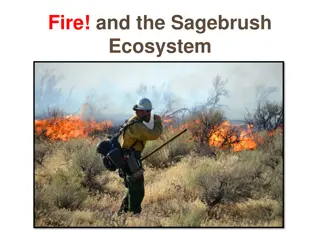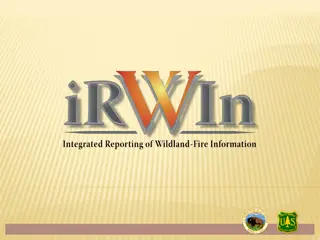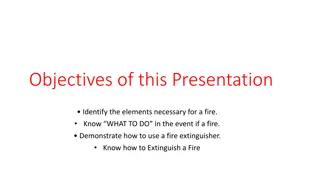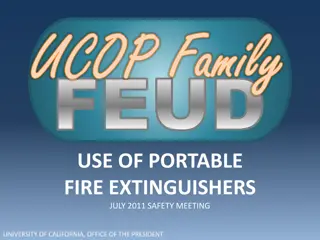Wildland Fire Overview in Canada: 2023 Season Update
Wildland fires in Canada are becoming increasingly severe due to climate change, with a high risk to Indigenous communities. The 2023 season has seen a significant increase in the area burned, with active fires posing risks to remote areas. National efforts are in place to manage these fires, with a focus on public safety and strategic coordination.
Download Presentation

Please find below an Image/Link to download the presentation.
The content on the website is provided AS IS for your information and personal use only. It may not be sold, licensed, or shared on other websites without obtaining consent from the author.If you encounter any issues during the download, it is possible that the publisher has removed the file from their server.
You are allowed to download the files provided on this website for personal or commercial use, subject to the condition that they are used lawfully. All files are the property of their respective owners.
The content on the website is provided AS IS for your information and personal use only. It may not be sold, licensed, or shared on other websites without obtaining consent from the author.
E N D
Presentation Transcript
Wildland Fire: 2023 Season Update and Federal Investments June 5, 2023
2 Background and Context Wildland fires are Canada s second most costly disaster. Climate change is increasing the frequency and intensity of wildland fires. The size of Canada s wildland-urban interface (WUI) is growing. Indigenous communities in Canada are at a higher risk.
National Roles and Responsibilities 3 Canadian Interagency Canadian Interagency Forest Fire Centre Forest Fire Centre Government of Government of Canada Canada Provinces & Provinces & Territories Territories Coordinates national/international resource support Strategic planning and information sharing National emergency management, coordination Wildland fire science, technology &expertise Public safety & education International agreements Federal lands Fire suppression Forest management Risk mitigation Emergency response Home of FireSmart Canada Indigenous, municipal, and regional governments play a critical role in fire and emergency management at local scales.
Area burned 4 Canada is experiencing an unprecedented amount of fire activity for this early in the wildfire season. The rate of increase of area burned to date is high. If this rate continues, we could exceed the largest total ever recorded in Canada.
5 Active Fires Currently 413 active fires (as of June 4, 23:30 ET) For this time of year, fire occurrence from coast to coast is not normal. Most fires tend to occur in the north away from large population centres, placing remote and rural communities at higher risk. Interface fires are the most detrimental and can cause tremendous economic and structural damage. The Canadian Wildland Fire Information System (CWFIS) provides 24-7 access to wildland fire information and data.
Year-to-Date (as of June 4, 2023) 2,214 fires nationally with approximately 3.3 million hectares (ha) burned o The ten-year average over same timeframe is 1,624 fires and 254,429 ha burned Evacuations: approximately 26,206 people currently under evacuation o +120,000 evacuated to date o Evacuations currently in BC, AB, NT, SK, QC, NS National Fire Preparedness Level: 5 o Full commitment of national firefighting resources, with ongoing extreme demand and international assistance required. Firefighting resources interagency deployments: o Canadians deployed through CIFFC: 198 o International firefighters currently in Canada: 957
Forecast: June 2023 Projections indicate potential for higher-than- normal fire activity across most of the country through to August. o For June, warm and dry conditions will increase wildfire risk across most of the country (BC to western Quebec).
Forecast: July & August 2023 Projections indicate potential for higher-than- normal fire activity across most of the country through to August.
9 Existing Federal Investments in Wildland Fire Improved emergency management and increased understanding of wildfire risk Enhanced wildfire research, modernized national wildfire information and decision- support systems Community-based wildfire firefighter training and equipment acquisition Enhanced resilience and emergency management of First Nations communities Increased wildfire management capacity in Canada s national parks Structural and natural infrastructure to mitigate disasters The Government of Canada also works closely with provinces, territories and whole-of-society partners on wildland fire prevention and mitigation. This includes renewal of the Canadian Wildland Fire Strategy (2016), the Blueprint for Wildland Fire Science in Canada (2019-2029), and most recently, the Canadian Council of Forest Ministers national Dialogue on Wildland Fire and Forest Resilience.
10 New Federal Investments in Wildland Fire WildFireSat Up to $169.9 million over 11 years Dedicated wildfire monitoring satellite system (first ever) Wildfire Resilient Futures Initiative Up to $284 million over 5 years Expand wildfire prevention and mitigation measures (i.e., FireSmart Canada); fill foundational gaps in wildland fire knowledge; and establish a Centre of Excellence for Wildland Fire Innovation and Resilience Disaster Mitigation and Adaptation Fund Up to an additional $489.1 million over 10 years to improve resilience of communities
11 How to build resilience All levels of Government Wildland fire response alone is no longer enough Individuals & Communities Forest Management Greater emphasis on prevention and mitigation by the whole of society is needed. Whole-of- Society Engagement Indigenous Knowledge Non-profit Sector Understand, engage, and act Business Sectors & Industry
12 ANNEX
Selected Federal Investments Related to Wildfire Resilience Budget 2022 provided: $269 million over five years, starting in 2022-23, to Natural Resources Canada to help provinces and territories procure firefighting equipment such as vehicles and aircrafts; $39.2 million over five years, starting in 2022-23, to Indigenous Services Canada to support the purchase of firefighting equipment by First Nations communities; $37.9 million over five years, starting in 2022-23, to Natural Resources Canada to train 1,000 additional firefighters and incorporate Indigenous traditional knowledge in fire management; $169.9 million over 11 years, starting in 2022-23, to the Canadian Space Agency, Natural Resources Canada, and Environment and Climate Change Canada to deliver and operate a new wildfire monitoring satellite system. Budget 2021 provided: $28.7 million over five years, starting in 2021-22, to Natural Resources Canada to support increased mapping of areas in Northern Canada at risk of wildfires and enhance the capacity of the Canadian Interagency Forest Fire Centre $100.6 million over five years, starting in 2021-22, to the Parks Canada Agency to enhance wildfire preparedness in Canada s National Parks; $1.375 billion over 12 years to renew the Disaster Mitigation and Adaptation Fund. Budget 2019 provided: $151.23 million over five years, starting in 2019 20, ($9.28 million per year ongoing) to improve emergency management in Canada, including in Indigenous communities; $211.0 million over five years, starting in 2019 20 ($49.4 million per year ongoing) to support increased resiliency and emergency management on-reserve; $48.0 million over four years, starting in 2020 21, to renew funding for on-reserve infrastructure projects to protect communities from climate-related hazards. Budget 2018 provided: initial investment of $2 billion over 10 years for the Disaster Mitigation and Adaptation (DMAF) fund. Budgets 2017 and 2016 provided: The Investing in Canada plan included $180 billion over 12 years for the Investing in Canada plan to modernize infrastructure across Canada (including rural and northern communities), to be delivered by 21 departments and agencies; $42.5 million in financial support from Infrastructure Canada (2016-2021) to the National Research Council of Canada for work to integrate climate resilience into building infrastructure, guides, codes. 13
Federal Government Roles Wildland Fire Public Safety Canada: The Government Operations Centre (GOC) leads federal response coordination for emergencies, which includes maintaining federal situational awareness, developing integrated risk assessments, and supporting response coordination. Canadian Armed Forces (CAF): May provide limited self-sustaining support to front-line relief operations, excluding social crises and enforcement/security tasks, once all available options have been exhausted, including PT and private sector. Natural Resources Canada (NRCan): Leads international memorandums of understanding/ arrangements for fire management cooperation and resource exchange; conducts monthly national fire season forecasting; provides wildfire intelligence and predictive services; and, monitors and reports on national fire locations and conditions. Environment and Climate Change Canada (ECCC): Provides specialized weather and wildland fire-related products and forecasts including air quality and smoke transport modeling, which could be used for evacuation planning and assessing potential health impacts. Indigenous Services Canada (ISC): Provides funding for preparedness, mitigation, response and recovery activities for on-reserve communities; helps facilitate the coordination of operations between FPT partners and supports impacted First Nations (FN); assists host communities with the delivery of services for FN evacuees; provides and makes arrangements for health programs and social services. Parks Canada Agency (PCA): Manages wildland fires across 350,195 km2 of federal Crown lands. Service Canada/ESDC: Facilitates access to services and benefits and flows resources quickly to those whose employment has been interrupted and require temporary income support, identity document replacements and to employers whose businesses have been also impacted. Public Health Agency Canada (PHAC): coordinates access to Health Portfolio health related supports; maintains the National Emergency Strategic Stockpile (NESS) which maintains emergency social services assets such as beds and blankets to support temporary accommodations for evacuations; work with ECCC to provide the Air Quality Health Index, health-risk messaging on wildfires and air quality. Innovation, Science and Economic Development Canada (ISED): Information gathering and sharing systems, networks and protocols to detect telecommunication disruptions or events of significance that facilitate effective communication and collaboration across the telecommunication sector/industry Transport Canada (TC): Situation Centre provides 24/7 monitoring of the transportation system and a single window for incident reporting by industry; facilitate transportation movement by issuing exemptions and adjusting regulatory requirements for air and rail when/where necessary. 14
